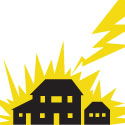So many times I hear about people who forget that a data connection whether it is a phone line or a network cable can also transmit a dangerous spike through to your computer. It’s entirely possible to fry your network adapter with a data line spike, and sometimes the spike to the network adapter can be powerful enough to damage other circuits on the motherboard as well.
Another common mistake is not protecting your laptop when plugged in. That little power adapter will do precious little to stop a surge of any kind short of the standard modulation of current we get through our power lines (dipping to 110, spiking to 125, depending on country and voltage of course) So why not protect your investment with a smaller more portable surge suppressor. APC for example makes one. The SurgeArrest Notebook Pro (click here for info) for instance. Nice and light, easy to pack in your bag and carry with you. Make sure you check the configuration of the surge suppressor though, there are many different inline models out there depending upon your specific power connection. If you are wirelessly connected for your data then the available models are even greater, something as simple as the Belkin Mini Surge Protector with USB Charger (click here for info) may be perfect for you. Its the one I use at home for the kids iPods when they are charging actually. Picked it up cheap at Target on sale for about $15 a while back.
I know adding more stuff to your notebook bag is not something most people want to do, but this is one of those items that could save you from replacing components or the entire laptop depending upon the severity of the power spike so I think its worth the space and added weight. An ounce (or a few ounces) of prevention as they say.
tcg

